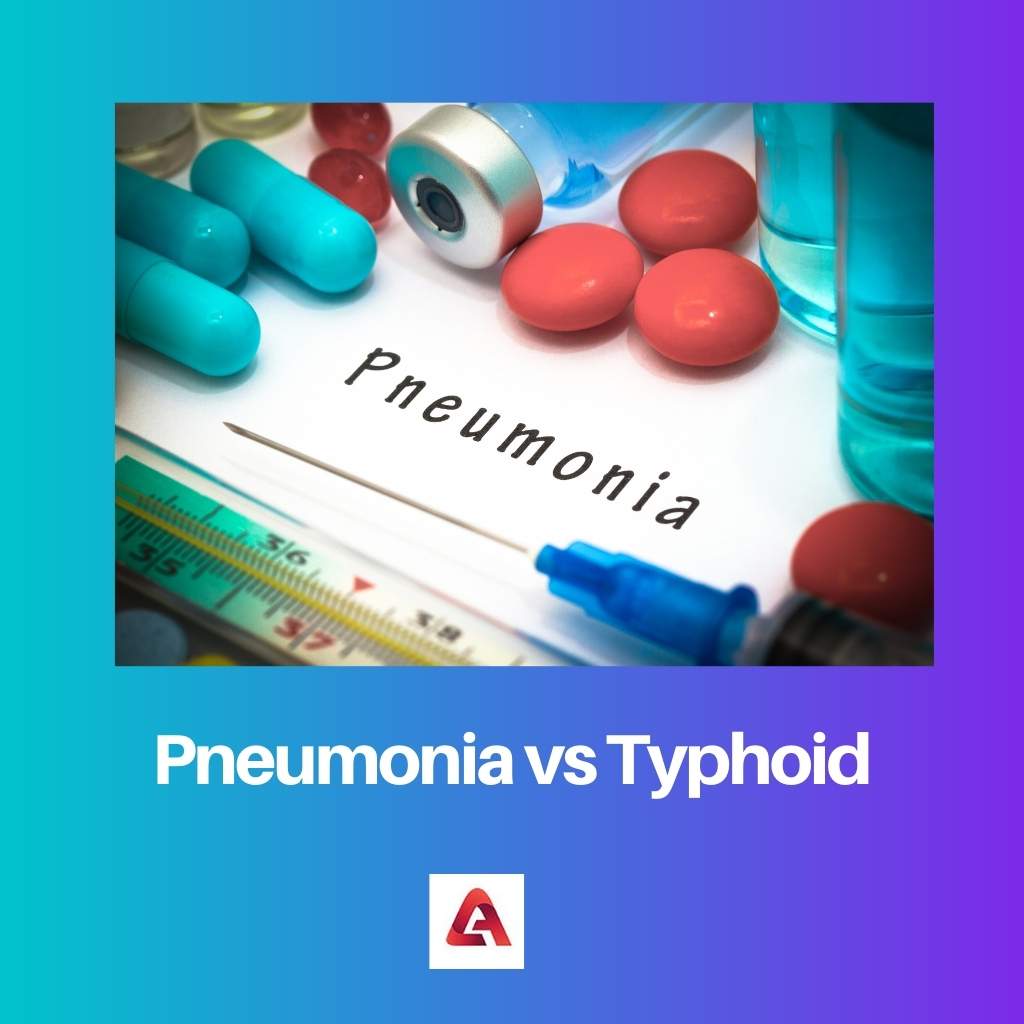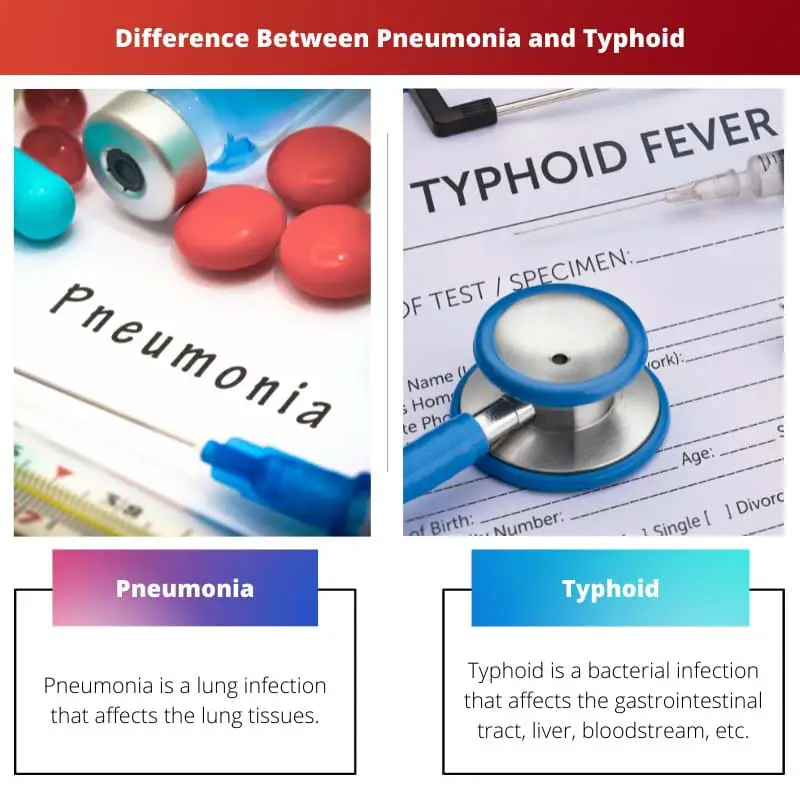Many infectious diseases have a set of common symptoms. Thus, with the occurrence of symptoms, it is easy to get confused as to what type of disease is causing the problems.
Hence, it becomes very important to get a full-body medical check-up from a doctor right when the symptoms start showing.
Key Takeaways
- Pneumonia is a respiratory infection, while typhoid is a systemic bacterial infection.
- Pneumonia affects the lungs, causing cough, fever, and difficulty breathing; typhoid presents with high fever, abdominal pain, and weakness.
- Bacteria, viruses, or fungi primarily cause pneumonia, whereas Salmonella Typhi causes typhoid.
Pneumonia vs Typhoid
Pneumonia is an infection that primarily affects the lungs. It can be caused by a variety of bacteria, viruses, or fungi and can lead to symptoms such as cough, fever, chest pain, and difficulty breathing. Typhoid fever is a bacterial infection that primarily affects the digestive system.

Pneumonia is a lung infection which affects the lung tissues. Different types of bacteria cause pneumonia, such as streptococcus pneumonia, mycoplasma pneumonia, Chlamydia pneumonia, etc.
Other than bacteria, pneumonia can also be caused by different types of fungi and protozoa present in the air or due to regurgitation of the content of the stomach into the lungs.
Typhoid is a bacterial infection that is very common in developing countries. The infection is caused by a specific type of bacteria, Salmonella typhi.
The disease is commonly caused due to the ingestion of contaminated food or water. The disease is highly transmissible and can easily be transmitted from person to person.
Comparison Table
| Parameters of Comparison | Pneumonia | Typhoid |
|---|---|---|
| Definition | Pneumonia is a lung infection that affects the lung tissues | Typhoid is a bacterial infection that affects the gastrointestinal tract, liver, bloodstream, etc |
| Causes | There are several causes of Pneumonia, such as different bacteria, viruses, fungi, etc | Caused due to bacteria called Salmonella typhi |
| Symptoms | High fever, chest pain, breathing difficulty, mucus in cough, etc | Diarrhea, abdominal pain, indigestion, vomiting, loss of appetite, etc |
| Treatment | For treating pneumonia, antibiotics, expectorant, antipyretics, and analgesics are used | For treating Typhoid, antimicrobials, followed by a strict fat-free diet is necessary |
| Number of cases | Very common. More than 10 million cases per year | Relatively rare. Less than 100 thousand cases per year |
What is Pneumonia?
Pneumonia is a lung infection that affects the lung tissues. It is a very common infection and is more frequent in cases of young children and the elderly. It affects the lung tissues and gives rise to breathing issues.
There are many causes of pneumonia, but the most common factor is a special group of bacteria.
Streptococcus pneumonia, Mycoplasma pneumonia, Chlamydia pneumonia, and Haemophilus influenza are some of the most common pneumonia-causing bacteria.
Along with bacteria, pneumonia is also caused due to different fungi, viruses, and other micro-organisms present in the air.
As we breathe, micro-organisms are sucked into the lungs, and because of their small size, sometimes they get inside the lung tissues.
They infect the lung tissues as they breed, and the damage is irreversible in some severe cases. Damage to the lung tissues gives rise to many severe respiratory problems.
Difficulty in breathing, chest pain, pain while coughing, presence of mucus in cough, wheezing, and high fever are some of the initial symptoms of pneumonia.
If the infection is not treated properly and quickly, it may lead to severe consequences. Antibiotics, either oral or systemic, and proper fluid level balance are some of the required initial treatment methods.
In some cases, oxygen therapy may also be recommended if the patient is unable to breathe properly.

What is Typhoid?
Typhoid is a bacterial infection that affects the digestive system. It is a highly transmissible infection, and cases are commonly seen during monsoon season.
Typhoid is caused explicitly due to a type of bacteria called Salmonella Typhi. The presence of this type of bacteria in food or water can result in typhoid.
Thus, consumption of food from unhygienic sources during monsoon is one of the major contributors to typhoid.
Salmonella Typhi affects the digestive system, specifically the gastrointestinal tract, which consists of the intestine, liver, and gallbladder.
The initial symptoms of typhoid are high fever, loss of appetite, abdominal pain, and diarrhoea. But in some cases, a person affected with typhoid may not show any symptoms.
Thus, it becomes very difficult to detect the problem in such asymptomatic cases. When the infection gets more severe, problems such as nose bleeding, painful cough, and abdominal distension and pain are also seen in patients.
Hence, a medical check-up in the initial stage is very important to prevent the disease from getting severe.
The treatment includes administration of antibiotics and antimicrobials, followed by a very strict diet planned by the doctor. The diet should be fat-free and in fluid form to help in easy and quick digestion.

Main Differences Between Pneumonia and Typhoid
- Pneumonia is a lung infection which affects the lung tissues. Typhoid is a bacterial infection which affects the gastrointestinal tract, liver, gallbladder, etc
- Pneumonia is caused by a lot of things, including different types of bacteria, fungi, viruses and other types of micro-organisms. Typhoid, on the other hand, is caused specifically by the bacteria, Salmonella Typhi.
- Symptoms of Pneumonia include high fever, chest pain, difficulty breathing, a painful cough, etc. Symptoms of typhoid include abdominal pain, diarrhoea, indigestion, vomiting, loss of appetite, fatigue, etc.
- For treating Pneumonia, antibiotics, antipyretics, expectorants and analgesics are prescribed. For treating Typhoid, different antimicrobials are prescribed. This is followed by a strict, fat-free diet.
- Pneumonia is a very common disease. It affects more than 10 million people every year. Typhoid is relatively rare and there are fewer than 100 thousand cases every year.

- https://www.sciencedirect.com/science/article/pii/S0140673610614596
- https://www.nejm.org/doi/full/10.1056/NEJM199512143332408
- https://www.scielosp.org/article/bwho/2004.v82n5/346-353/
- https://www.nejm.org/doi/pdf/10.1056/NEJM197010012831406

It’s scientifically accurate and written concisely.
The information provided is comprehensive.
I really appreciate the detailed information.
The content is enlightening, thank you.
Thank you for the comparison table. It was helpful. It makes it easier to understand.
This article is very informative and useful
Well written and educational, thank you.
What an impressive and valuable article.